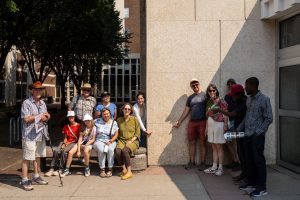
Adventures for Wilderness, Calgary Fossil Discovery – August 3, 2024
August 8, 2024
- •
- •
- •
Text by Ruiping Luo
Photos by Katherine Cheng
When most people think of cities, they think of the infrastructure – skyscrapers of concrete and glass, winding roads with flashy cars, a few quieter pockets of green spaces and unassuming homes. Most people don’t think about fossils. Fossils belong to the badlands, or the mountains, far from human civilization.
Yet, overlooked by most of the daily commuters, Calgary has fossils. Not hidden in a museum, carefully labeled and curated, but out in the open, accessible to anyone who takes the time to look.
Tako Koning, a professional geologist with an interest in Tyndell Stone, looked. Starting right in Kensington, he shared the secrets hidden in some of Calgary’s otherwise inconspicuous stones.
Tyndell Stone, from the Ordovician Red Rock Formation in Manitoba, is a popular building and ornamental stone. The light rock, shot through with darker patterns, is valued for its color and durability, and lines the walls of many buildings throughout Canada and the United States. It is also highly fossiliferous – numerous fossils are found within the rock. In fact, the pattern seen on these stones is a result of ancient organisms that burrowed through the deposit, leaving behind a network of darker rock.
Starting at the decorative rocks outside Kensington’s Safeway, we looked at the 450 million-year-old rocks scattered around the block. Along with the prevalent tunnels, strange circular patterns showed where prehistoric sponges, corals and gastropods had lain. From there, we moved to the Senator Patrick Burns Building, only a few blocks away, where the stone columns are decorated with ancient life forms.
Watching Tako point out the unusually unnoticed patterns, we left with a new understanding of the creatures hidden within our city – creatures our city was built from.


